Recognizing the top seven performers of the 2023 season.
June 12, 2023 by Jenna Weiner and Keith Raynor in Awards with 0 comments
Each year, Ultiworld presents our annual College Awards. Our staff evaluates the individual performances of players from throughout the season, talking to folks around college ultimate, watching film, and look at statistics, voting upon the awards to decide those to be honored. The regular season and the college Series are both considered, with extra emphasis for performances in the competitive and high-stakes environment at Nationals.
Our All-American teams recognize the top performers across the division. While in the past we have closed our Awards with our First Team and Second Team, displaying the top seven and next seven players who had the best seasons, they have been moved up in the schedule. As our voting process is ordered, the top two vote-getters for All-American honors, excluding the Player of the Year, will be recognized as our Player of the Year runner-ups. As such, those three players are listed in order, with the runners-up identified; the other four players are listed in alphabetical order.
- Player of the Year
- All-American First Team
- All-American Second Team
- Breakout Player of the Year Award
- Rookie of the Year Award
- Offensive Player of the Year Award
- Defensive Player of the Year Award
- Coaches of the Year Award
D-I Women’s All-American First Team
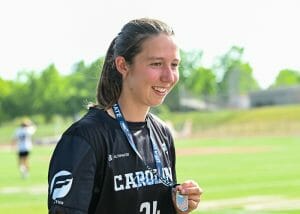
Alex Barnett (North Carolina) Player of the Year
One of the challenges Ultiworld staff talk about when making award selections is how difficult it can be to recognize individual brilliance on deeply talented teams. Barnett has found a way of skirting around that issue by simply acting as a multiplier for her teammates. The UNC field general is an RPG-style stats buff from a support character who also happens to be a totally OP powerhouse that could probably use a nerf. Rare is the player who can handle so much responsibility while making so few mistakes. A brilliant package of high-IQ physicality, creative and evasive throwing, and a pure joy sparked by competition made Barnett a college star unlike almost any other we’ve seen.
For more on Alex Barnett, check out her Player of the Year writeup.
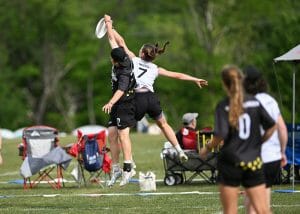
Abby Hecko (Washington) Player of the Year 1st Runner-up
After adding the Callahan to her growing trophy cabinet, Abby Hecko once again finds herself amongst the best the division has to offer. With the likes of Steph Phillips, Ikran Elmi, and Mae Browning leaving the Element program after last season, Hecko took on a somehow even larger role for Washington than in seasons past. At Nationals, the Seattle superstar put up a triple-double of goals, assists, and blocks with 16, 19, and 11, respectively, and recorded the best +/- of any player of the tournament with a +33 final total. It was a statistically stunning display, and a demonstration of Hecko’s excellence in all facets of the game.
As the Callahan winner, though, Hecko’s contributions to Element’s success weren’t purely limited to the field. In Washington’s extended prequarters win over Oregon, Hecko took the lead as her team rallied late, taking over on the field and serving as one of Element’s emotional leaders off the field as they booked their spot in the quarterfinals. For a Washington team that found itself beset by injuries over the course of the entire season, Hecko was a constant, and her stellar play reaffirmed her place at the top of the division at the end of her final collegiate season.
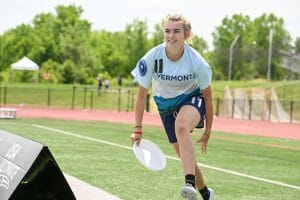
Kennedy McCarthy (Vermont) Player of the Year 2nd Runner-up
We’ve gotten pretty used to the dominance of Kennedy McCarthy. For years, she has ruled the skies of the college division, and she was winning Club awards (Breakout Player of the Year) way back in 2019. And perhaps we’re all a bit jaded. Are the aerial exploits just not quite as explosive as before? The fastball hucks just not quite as wow-inducing? The layouts just not quite as UltiPhotos worthy?
Yeah right. You can tell yourself that in the interest of finding new stars, because that may be easier than finding new answers to the problem McCarthy presents to her opponents. Her team has made an occasional crack about how much attention she draws, but they are thankful for her gravity once she takes the field and demands a response from the defense. If she’s going to keep growing her game and fending off challenges, we’re going to keep grinning at the highlights she produces.
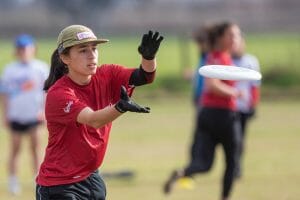
Esther Filipek (Stanford)
Many — heck, almost every — college team has been defined by the player of their highest-volume handler. They are the lifeblood of college ultimate, the primary resource that powers the whole thing. There’s a pretty strong correlation between how well that player plays and how good a season a team has.
Well, Stanford Superfly had a pretty damn good season. And a lot of the credit should be flung towards Esther Filipek, with all of the gusto she sent deep shots hurtling the length of the field past the craning necks of wide-eyed defenders. The lefty handler was not shy about unleash her powerful puts to a variety of swift targets, few of which could escape the crosshairs of her sharp vision.
Perhaps influencing that penchant was Filipek’s defensive capabilities. It is not by chance that she generated 13 blocks at Nationals. You can feel a bit more comfortable taking risks when you know that you can pick up yards with your takeaways the other way. Filipek was especially effective directing traffic in Stanford’s various zones, plugging holes while helping her teammates shut down new lanes as they spawned.
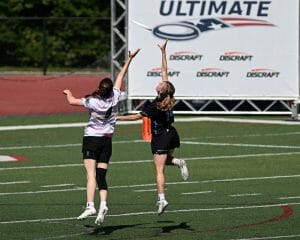
Ella Juengst (North Carolina)
It sometimes feels impossible for players who already seem to be at the top of their games to take it up another level – and then there’s Ella Juengst, blowing by her opponents with rhythmic regularity. Her ability to generate space was near unmatched, and at times it almost appeared that Juengst was unmarked with how open she was able to get, even against many of the best defenders in the division. That’s an impressive feat in any context, but especially so when you consider that teams would have been targeting Juengst as a key piece of the UNC offense, and despite their best efforts, she made them pay time and again anyway.
During her time with the Pleiades, Juengst has earned many a nickname given her propensity for catching score after score at the front corner of the end zone. While she still contributed her fair share of goals, 17 total over four days in Ohio, Juengst also threw double-digit assists and half that more in blocks. Alongside only four turns, it made for an incredible level of efficiency from UNC’s speediest superstar, and helped Juengst earn All-American recognition one last time after her final season with the Pleiades.
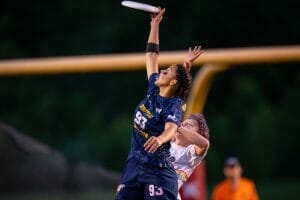
Mika Kurahashi (British Columbia)
Sometimes, it takes just one point, one sequence, to exemplify a player’s extraordinary abilities. In Mika Kurahashi’s case, her back-to-back blocks against Colorado in the semifinal showdown did just that. Peak athleticism? Check. Outstanding heads up play? Definitely. Willing to put everything on the line to try and lead her team to victory? You bet.
View this post on Instagram
Kurahashi’s game already possessed a razor-like sharpness, able to pierce through the odds to make room for her own willpower and flare to make the big play. What took her to the next level were the other capabilities she developed for battle, a trove of tactics and skills that filled out Kurahashi’s game and filled up the scoreboard.
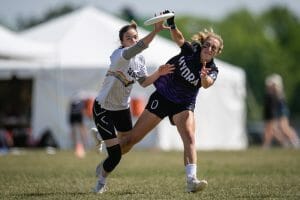
Bailey Shigley (Colorado)
Shigley has shown incredible resilience in her return campaign, after spending an extended time spanning multiple seasons watching from the sidelines through injury. For her to take the field with one of the strongest teams in the country, to reintegrate and compete, is impressive enough on its own.
But at this level? As one of the best players in the entire division? Practically unheard of. She led Quandary in assists (19), was second in goals (10) and blocks (7), while leading the team in yardage in both their semifinal win over UBC (despite playing only 11 points) and in their matchup against UNC.
It is wonderful to be able to come full circle on Shigley, who launched into college with a tremendous rookie season that hinted at her ability to be a leader in the division. That two-way excellence came to fruition, after a long and winding journey.